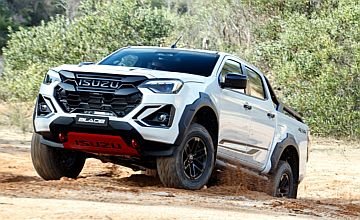OptionsCar reviews - Isuzu Ute - D-Max - BladeIsuzu Ute modelsOverviewWe like Much better clearance off-road, tyres and underbody protection improve confidence, revised capability makes it more competitive, also better on-road Room for improvement No more power or torque, less grunt than many rivals, sticker packs cheapen the look, relatively tall asking price Ute maker teams up with Walkinshaw for an impressive off-road-focused model1 Nov 2024 THE recipe is a good one – take a competitive dual-cab ute and modify it with the expertise of Australian engineers to understand what buyers actually do with their double-cab trucks.
And that’s precisely what Isuzu Ute Australia has done with the new D-Max Blade, having paired up with Walkinshaw Automotive for a bespoke tuning and styling program to create a rough-road-ready range-topping version of the popular Japanese-branded pick-up.
That’s right – the carryover 3.0-litre turbo-diesel four-cylinder hasn’t been tickled, with 140kW/450Nm on offer still. Based on the LS-U+ spec, the Blade comes with a six-speed auto as standard, and a selectable 4x4 system with a locking rear differential. Fuel use is the same as the pre-existing spec, at 8.0L/100km.
See our earlier pricing and specifications story to see what’s changed in detail, but the at-a-glance revisions comprise a reworked chassis with raised suspension and Monroe shock absorbers, reinforced underbody protection and rated recovery hooks, a light-bar, side-steps, a sports bar, tub liner, and 18x7.5-inch wheels with all-terrain tyres. Inside, changes are restricted to Blade embroidered headrests and carpet mats.
Owing to it being based on the LS-U+ spec, it has heated front seats with driver’s electric seat adjustment, leather-accented seat trim, climate control air-con, a leather-lined steering wheel, part-digital instrument display and the recently improved 9.0-inch touchscreen media system with Apple CarPlay, Android Auto, and knobs and buttons for easier use.
Blade has the maximum 750kg unbraked / 3500kg braked towing capacity, and unlike some of the other utes in this hardcore 4x4 design, it has a strong payload capacity – 896kg. That’s what Isuzu was on about when they said that this was all about “capability without compromise”.
The Japanese brand and the Aussie modifier have worked closely to ensure that any and all changes made do not impact the quality and usability of the ute’s safety systems. The D-Max retains its five-star (2022) ANCAP score, but the Blade, specifically, hasn’t been tested.
Isuzu offers a six-year/150,000km warranty for the D-Max, and the Blade changes fall under that warranty, too. There is a capped-price service plan for five years ($449 per visit, due every 12 months/15,000km) and buyers get seven years of roadside assistance, too.
Driving impressions
At the launch of the D-Max Blade there was a mix of different testing scenarios on offer.
I get it, it’s more of a lo-fi experience here, but having said that, there was no touchdown of bashplates, with the extra track width and tyre traction offering surefooted progress in slow-moving situations.
Down at Goolwa Beach it was time to test out the sand-driving capabilities of the D-Max Blade, and it cut through the hard-pack wet sand in high-range (with all the traction control assistance switched off) with ease. In looser sand it was manageable on the throttle, and the extra purchase from the deflated (20PSI) tyres made for relatively smooth progress.
We even got a chance to test out those new dampers with a small jump up a dune cliff, and while it was bumpy, the body remained under control in this more challenging higher-speed off-roading.
What about on-road?
There have been improvements to the ride, courtesy of those new shocks, and the steering, thanks to the changes made to the tune and geometry adjustments, but to my mind it’s still not quite as comfy or pinpoint accurate as a Ford Ranger.
Look, the engine and transmission are fine in the majority of situations, but this is certainly not a fast ute. The 4JJ3 turbo-diesel is a lazy thing that’s tuned for reliability, and despite the fact this would have been a fitting case for a power bump, it still feels a bit breathless at times under full throttle, where rival utes have more easy-going pace on offer.  Read more |
OptionsClick to share
|















Facebook Twitter Instagram